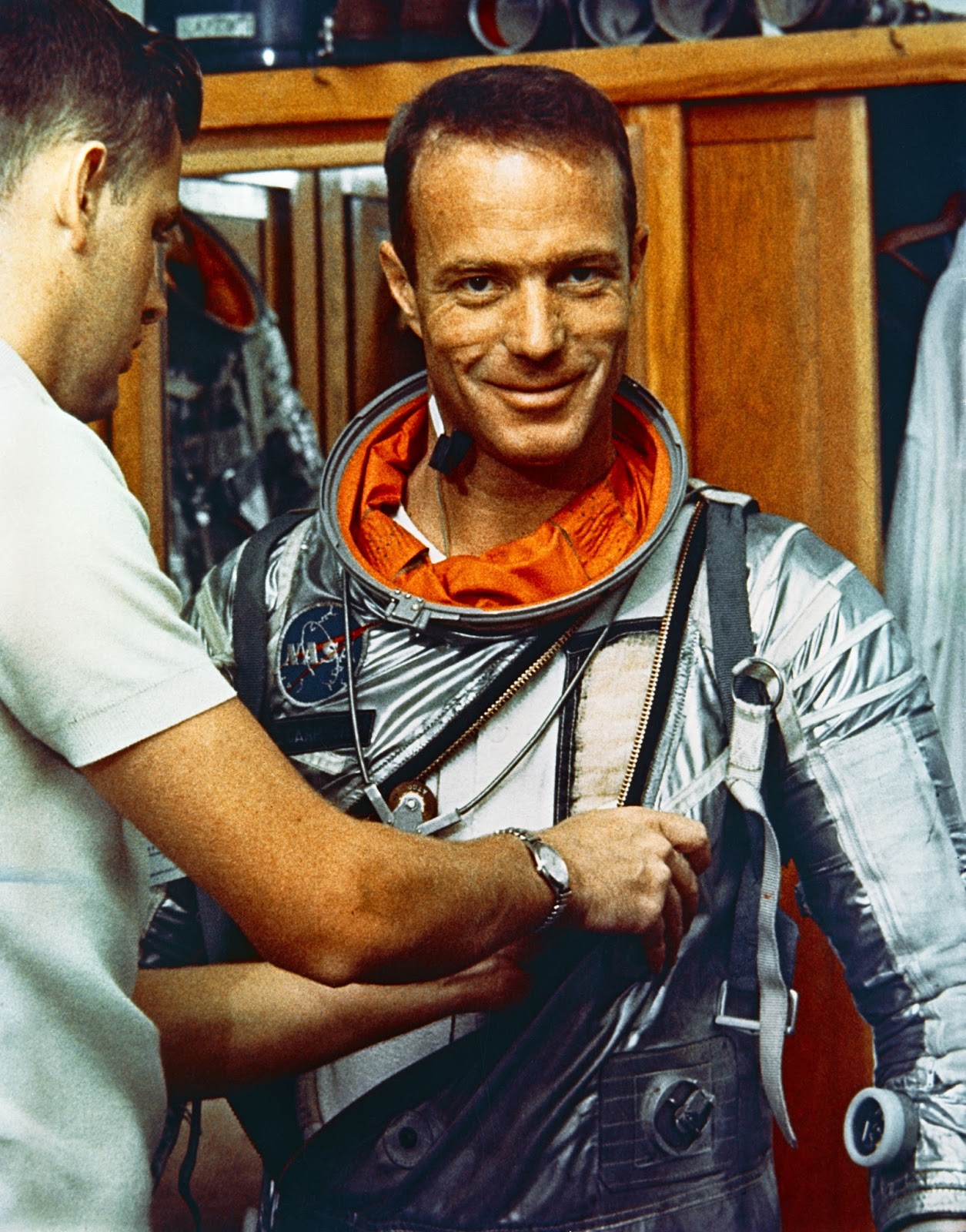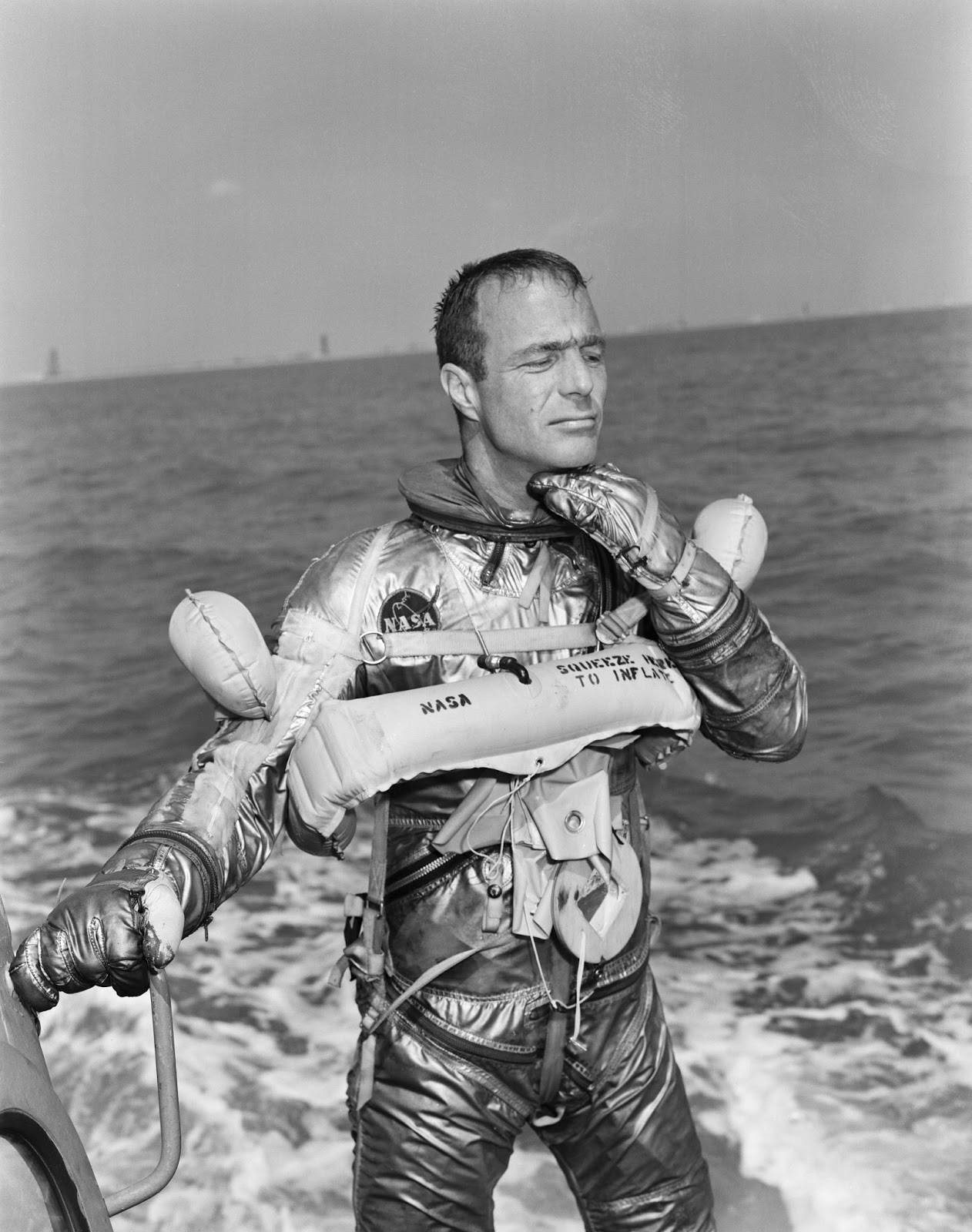In my estimation, Mercury Seven astronaut Scott Carpenter has been the target of some rather unfair attacks from many people concerning his performance during his 1962 Aurora 7 orbital mission. That topic merits a whole separate blog post in itself, but to be blunt, Carpenter’s own account is best told in his autobiography For Spacious Skies, co-written with editor and writer Kris Stoever (who is also the astronaut’s daughter). Out of respect, I think I’ll let the man – who left us in 2013 – tell that story himself. While that subject has been somewhat “controversial,” a couple of thingscannot be disputed: Carpenter more than earned his place among the greats in spaceflight history, and deserves respect.
It does bear mention, however, that Carpenter’s pioneering spaceflight was just the precursor (not to diminish his space experience at all) of his next milestone in exploration: 1965’s undersea jaunt aboard the habitat Sealab IIin Scripps Canyon, just off the coast of La Jolla, California. This period in Carpenter’s career directly contributed to how astronauts are trained for modern-day International Space Station (ISS) missions, but sadly these kinds of things get lost in history. Let’s brieflyrevisit Scott Carpenter’s love affair with the sea. Why did it capture his imagination, and why did he enter it so eagerly?
For Spacious Skies recounted that Carpenter’s desire to conquer the ocean came from an event that took place during Navy water survival training while he was stationed in Hawaii between 1951 and 1954. When he and his crew jumped off a Navy boat to set up a raft and other equipment, a corner reflector fell off the boat; this reflector was vital in case an airplane had to locate a raft at sea. A gunner dove and retrieved the reflector, but Carpenter had hesitated. The book stated that this incident strengthened the future astronaut’s resolve: “He, the commanding officer, had hesitated when his gunner’s mate had acted. He resolved to conquer his fear in an effort that would take him again and again into the water.”
Fast-forward to 1964. Carpenter, who had recently been in a devastating motorcycle accident, found himself grounded from spaceflight when a broken left arm had healed “too well,” limiting itsmobility. The astronaut had already gained experience in diving, and was already involved in the U.S. Navy program known as “Sealab,” having expressed an interest in deep-sea exploration to Jacques-Yves Cousteau (no stranger to the sea himself). He threw himself into preparations for his role as the commanding officer of Sealab II.
Sealab II was almost like an underwater space station. The 1967 World Book Year Book described the habitat in detail as “a 58-foot cylindrical craft weighing 200 tons…designed to operate to depths of 400 feet. Its walls are made of steel one inch thick. This enables it to withstand pressure of 200 pounds per square inch.” Its atmospheric pressure was kept at 94 pounds per square inch, vital for keeping seawater out of its specially-designed, 48-inchhatch. The aquanauts could leave or enter directly from air to water, or from water to air, Carpenter wrote in an accompanying article called “Man of Two Worlds.” The aquanauts inside breathed a helium-rich atmosphere, resulting in “Donald Duck” vocalizations.Notably, the internal temperature was kept at a seemingly toasty 91 degrees Fahrenheit; World Book explained this was the case because the men inside lost body heat more rapidly due to the helium atmosphere.
Sealab II waslowered to the ocean’s floor on Aug. 28, 1965. The habitat would spend 45 days on the sea’s floor, with Carpenter staying aboard for 30 days. While it would be easy to draw direct comparisons to his
experiencein space to his life under the sea, Carpenter refuted that in his article:
Man’s exploration of the sea cannot yet be compared to manned spaceflights since the latter involve sophisticated equipment and advanced scientific techniques. Yet I have found that the problems of putting man beneath the surface of the sea are related in a number of ways to the task of making him effective in space. In the underwater program, for instance, we must select and train crews, design new types of capsules, devise special tools, provide a viable atmosphere, plan and conduct a schedule of unprecedented scientific experiments – requiring extensive extra vehicular activity – and conduct physiological and psychological tests on man outside his natural environment. Man leaves his natural environment not without some hazard, and a few surprises since he has become conditioned to it through eons of existence in the earth’s atmosphere.
Carpenter continued that unlike space, the undersea environment was teeming with diverse life. The crew even worked with a “highly trained and friendly” dolphin, Tuffy, who on occasion delivered supplies (a living “cargo ship,” if you will). But the environment did have some similarities to life in space. Basic tasks such as cooking posed a challenge due to the habitat’s unique atmosphere. Personal space was described as “extremely limited.” And the crew, just like astronauts aboard a space station, was able to complete 44 scientific experiments inside and outside the habitat.
Shortly after Carpenter’s return to terra firma, NASA began investigating new ways to train for extravehicular activities (EVAs). For Spacious Skies underscored that he was an early proponent of training astronauts for “spacewalks” in a neutral buoyancy environment. This wayof training astronauts for EVAs has been used since the mid-1960s. In addition, astronauts, engineers, and scientists participate in today’s NASA Extreme Environment Mission Operations (NEEMO) project, which sends budding “aquanauts” to an undersea habitat called Aquarius for three weeks at a time to train in scenarios they may encounter in spaceflight. Sound familiar? NASA stated on the NEEMO web page, “The Aquarius habitat and its surroundings provide a convincing analog for space exploration.”
Carpenter wrote in the mid-1960s, “If Sealab studies and related scientific programs can solve the problems of living and working at an ocean depth of 850 feet, then we will have gained access to an area which must certainly prove to be an incalculable asset to our nation.” His words were prophetic: Carpenter’s contributions to space and sea left a rich legacy, and can be felt in today’s ongoing ISS operations (and undoubtedly future deep-space missions).
Emily Carney is a writer, space enthusiast, and creator of the This Space Available space blog, published since 2010. In January 2019, Emily’s This Space Available blog was incorporated into the National Space Society’s blog. The content of Emily’s blog can be accessed via the This Space Available blog category.
Note: The views expressed in This Space Available are those of the author and should not be considered as representing the positions or views of the National Space Society.




















